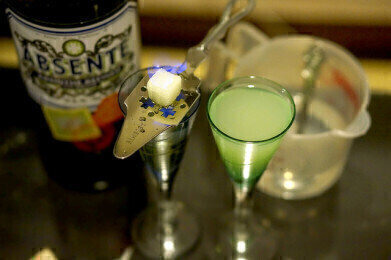GC, MDGC
Why Was Wormwood Absinthe Banned? Looking Back 100 Years with Chromatography
Nov 24 2014
Going back millennia, the herbal plant wormwood has been used for medicinal purposes to combat back pain, menstrual pain, venereal disease, anaemia and jaundice. The first documented use of the substance appears in the Egyptian scroll Ebers Papyrus from 1550BC; however, the document itself is a compilation of texts going back as far back as 3500BC, suggesting that wormwood may have far older origins.
In the 18th century, the herb began to be distilled for use as a recreational liqueur, with its current embodiment believed to have been invented by French physician Pierre Ordinaire and popularised by commercial producer Henri-Louis Pernod in the 1790s. Since then, its popularity steadily grew, being used and memorialised by such artistic greats as Pablo Picasso, Ernest Hemingway and Oscar Wilde. However, over 100 years ago, the popular liqueur (by then known as absinthe) was banned in most countries around Europe, starting with Switzerland. Why?
The Devil behind the Green Fairy
Absinthe’s fall from grace was as swift as it was absolute. By 1915, most countries around the world had outlawed the substance, believing it to be responsible for insanity, sexual deviance, a general slipping of standards in French culture and customs and even their poor showing in the First World War.
This ill-feeling towards the spirit came to a head in 1905, when a Swiss peasant murdered his whole family under the influence of absinthe (among other intoxicants), prompting the town's mayor to condemn the spirit as “the principal cause of a series of bloody crimes in our country.”
Though this was the direct catalyst for its banning, absinthe’s reputation had suffered in the years building up to the murders due to the findings of influential psychiatrist Valentin Magnan. After conducting experiments on animals comparing the effects of absinthe with other forms of alcohol, Magnan concluded that absinthe was a different kettle of fish from the rest and as such, should be regarded as absinthism, not alcoholism, and should be banned outright.
Innocent Scapegoat or Evil Influence?
Though Magnan’s findings were denigrated by many scientists of the time, his opinions were repeated often enough to signal the beginning of the end for absinthe’s heyday. But were his accusations justified?
A 2008 study led by Dirk W Lachenmeier, a food chemist, aimed to put the mystery of the green fairy to bed once and for all. Mr Lachenmeier used chromatography to analyse samples of absinthe from its pre-ban state, through its contraband incarnation to the modern day version. The process of chromatography, used to separate out a compound into its various components, was concerned with one substance in particular: thujone. This was the property believed to be responsible for the hallucinatory and damaging aspects of absinthe, as well as having the potential to become toxic in large amounts.
The findings revealed that there were no major discrepancies between the thujone levels in the samples, indicating that there was not much to separate absinthe from other forms of alcohol of the time. Bearing in mind that the Swiss peasant had imbibed copious amounts of wine, cognac and other spirits, and that those artists who used it heavily (often to their own deterioration) used others as well, it seems more than likely that the green fairy was made a scapegoat to allowed wine production to flourish unhindered in an otherwise flagging French society.
Chromatography to the Rescue Again
This is not the first time that chromatography has been used to analyse alcoholic content. Famous German spirit Jägermeister regularly uses high performance liquid chromatography (HPLC), gas chromatography (GC) and mass spectrometry (MS) to ensure quality standards in its composition. You can learn more about this application in this article: Jägermeister - Quality You Can Taste.
Meanwhile, this article, Analysing Imported Wine and Sparkling Wine, discusses how Chinese customs are employing chromatography methods to test incoming batches of wine and assure their quality. So remember that the next time you’re supping on a delicious aperitif, cocktail or vintage – you could have chromatography to thank.
Image Source: Absinthe
Digital Edition
Chromatography Today - Buyers' Guide 2022
October 2023
In This Edition Modern & Practical Applications - Accelerating ADC Development with Mass Spectrometry - Implementing High-Resolution Ion Mobility into Peptide Mapping Workflows Chromatogr...
View all digital editions
Events
Apr 23 2024 Kintex, South Korea
Apr 23 2024 Seoul, South Korea
Apr 28 2024 Montreal, Quebec, Canada
May 05 2024 Seville, Spain
May 15 2024 Birmingham, UK














